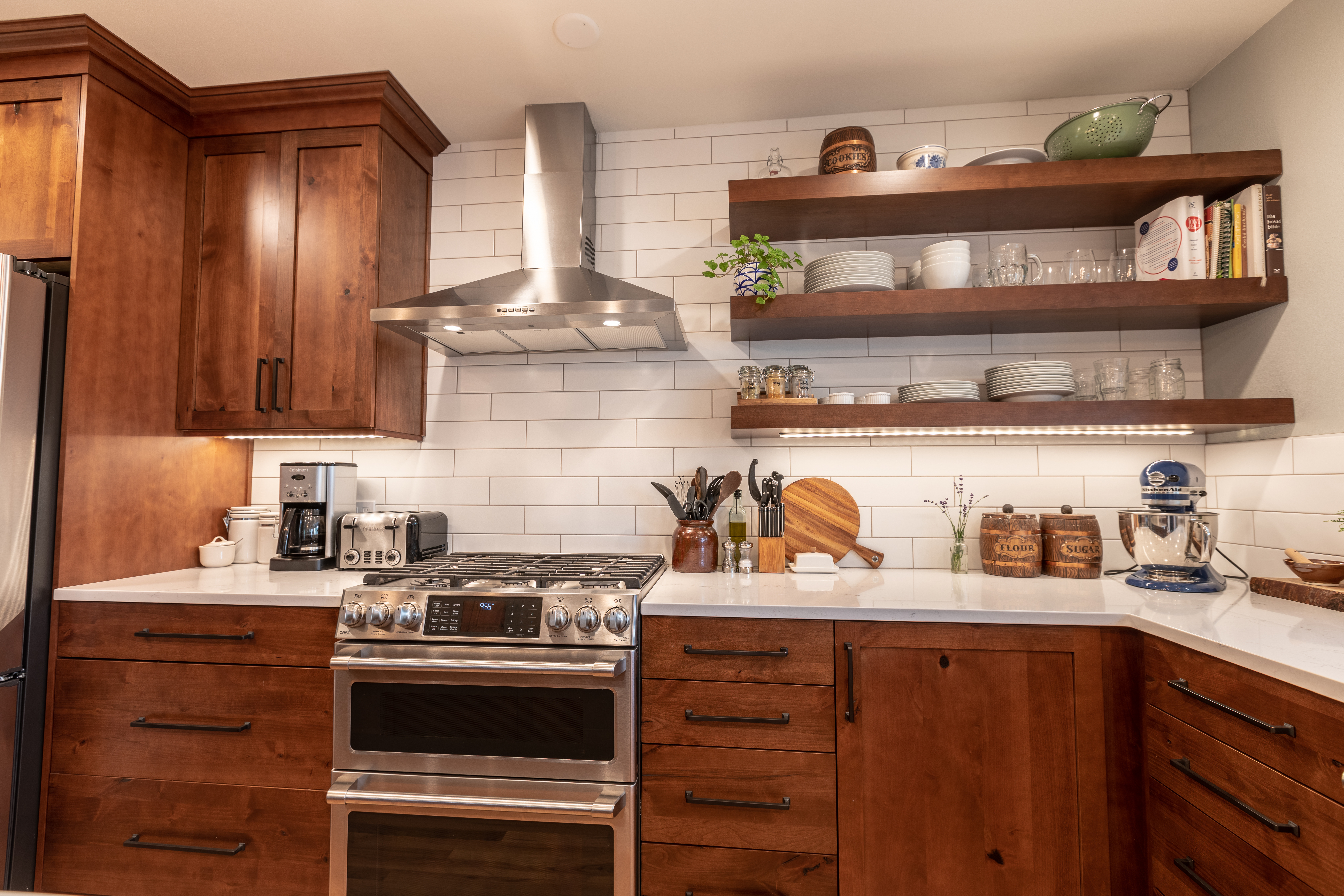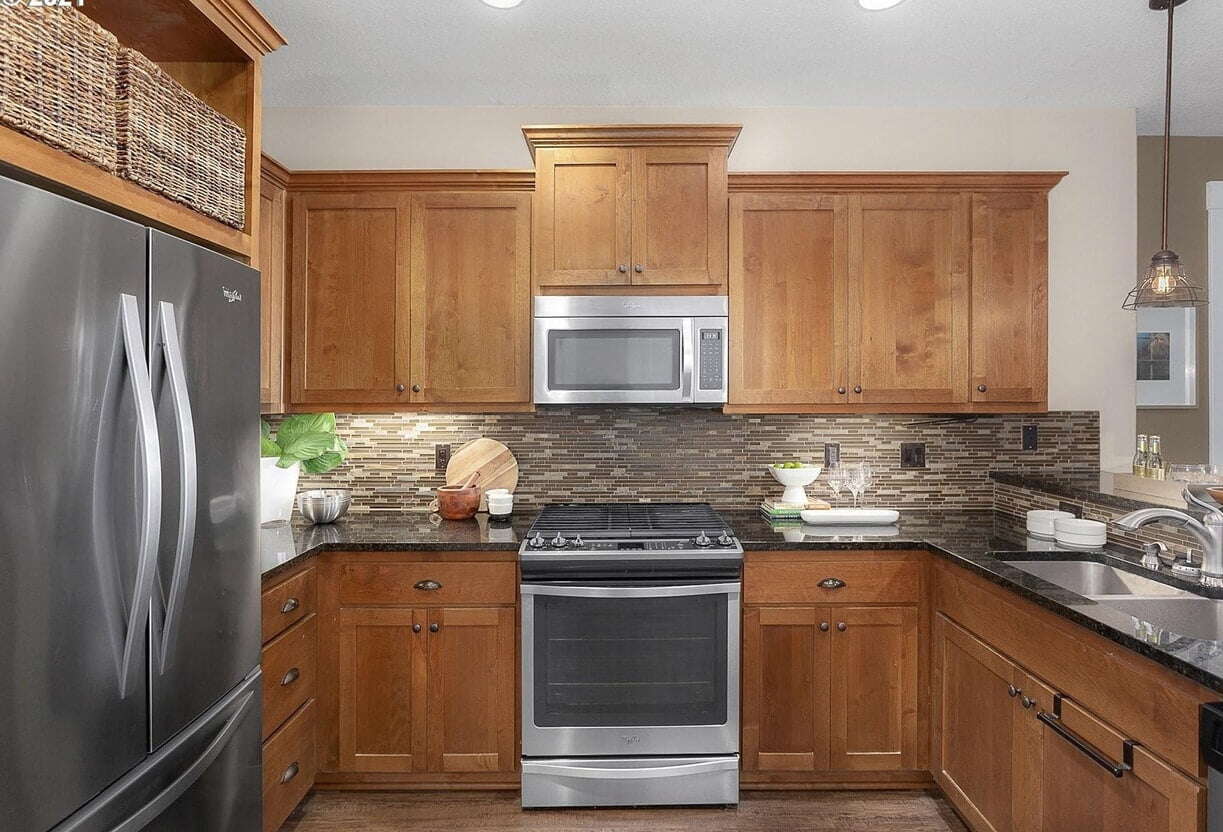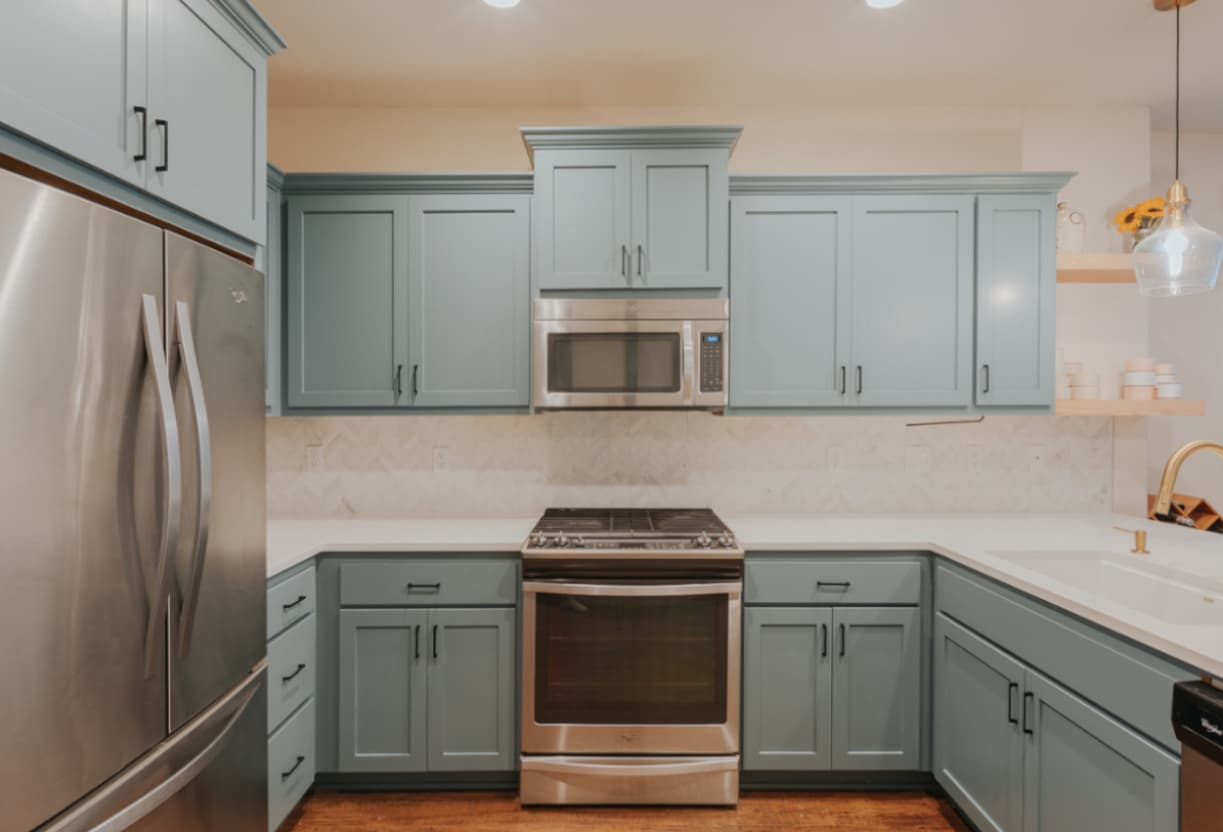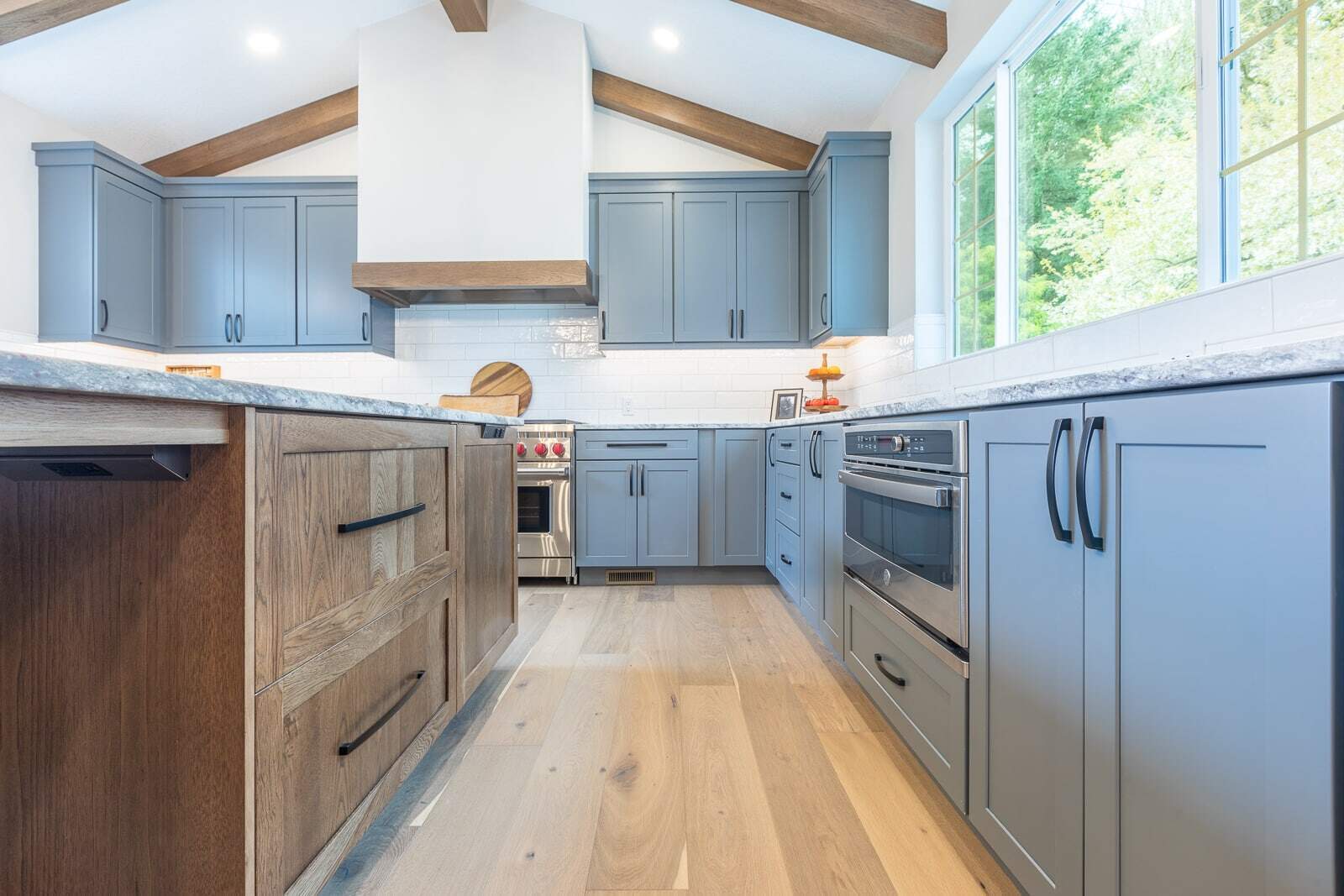The journey of choosing the right cabinets for your kitchen remodel can be daunting. There’s a multitude of options, each with its own advantages and disadvantages. In some cases, homeowners find themselves torn between the timeless charm of wood cabinets and the modern allure of laminate, wondering which is the best choice for the kitchen of their dreams.
At Lamont Bros. Design & Construction, we’ve guided countless homeowners through this exact journey. We often receive questions about the pros and cons of wood versus laminate cabinets. With years of experience in the remodel and design industry, our team understands these materials, their strengths, weaknesses, and the contexts in which each shines the brightest.
This article will dive deep into the differences between laminate and wood cabinets. By the end of your read, you’ll not only be well-versed with the qualities of these materials but also armed with the knowledge to make an informed decision that aligns with your home’s needs. Specifically, we’ll discuss:
- The Difference Between Wood and Laminate Cabinets
- Comparison of their Strengths and Weaknesses
- How to Decide Which Type of Cabinets is Best for You
Defining Laminate and Wood Cabinets
Before we plunge into their strengths and weaknesses, it’s essential to understand the difference between wood and laminate cabinets.
Wood Cabinets
Wood cabinets are typically crafted from hardwoods like oak, maple, or cherry. The choice of wood often influences the cabinet’s color, durability, and cost.
Most often, the cabinet boxes are made of plywood. Meanwhile, the doors and drawer faces are solid wood. This helps to maintain the natural woodgrain appearance on all surfaces of the cabinet.
While wood is often associated with classic and traditional designs, it is versatile enough to be adapted into more contemporary styles. From ornate carvings and moldings to minimalist, clean lines, wood can transcend design eras effortlessly.
Laminate Cabinets
Like traditional wood cabinets, laminate is made using wood products. However, these cabinets undergo a much more extensive manufacturing process.
To make laminate cabinets, wood fibers are combined with hard resins and cured using high heat and pressure. The resulting planks are then laminated with a decorative covering and a protective outer layer.
As manufacturing technology has developed, laminate has become a formidable force in the cabinet material market. Today’s options range from mimicking the look of real wood to showcasing sleek and glossy finishes, making it a fitting choice for contemporary kitchens.
Laminate vs. Wood: A Comprehensive Comparison
When choosing between laminate and wood for kitchen cabinets, understanding their distinct characteristics across various parameters is crucial. Let’s delve into the differences and advantages of both materials.
Appearance and Aesthetic
The cabinets in your kitchen will take up a lot of visual space. It’s important that the cabinets you choose meet your expectations when it comes to how they look.
Wood
Natural and Unique: The beauty of wood stems from its natural grain patterns, offering an authentic style to your kitchen. Wood cabinets tend to have the most visual impact when finished with stain rather than paint, allowing the natural grain of the wood to show through.
Intricacy and Customizability: Wood cabinets offer unparalleled versatility, allowing for crafting and milling highly intricate designs. Whether seeking decorative edges, detailed doors, or elaborate crown moldings, wood is a top choice for customizability.

Laminate
Edge Banding: One important feature of laminate is its edge banding. Although laminate cabinet surfaces can mimic real wood textures, the edge of the doors and boxes can’t be finished with the same laminate covering as the rest of the boards. As a result, the manufacturers will usually add edge banding along the thin edge of the cabinets. While not a big deal, some homeowners don’t like the visual appearance of the edge bandings.
Surface Quality: Laminate cabinets provide an excellent surface for solid color cabinets. For this reason, they do especially well for kitchens with traditional solid white cabinetry. Laminate can even be made to resemble real wood grains. However, there are some intricate details laminate just can’t replicate.
Durability
While you want your cabinets to look great in your newly remodeled kitchen, it’s equally important that they serve your needs for years to come. Here are a few things to consider about the durability differences between wood and laminate cabinets.
Laminate:
Laminate’s standout quality is its superior scratch resistance. Thanks to its laminated protective layer, these cabinets can withstand everyday wear and tear with impressive resilience. This makes them excellent cabinets for homes with young children, who tend to be rough on nearly any finished surface in a home.
Wood:
After several years of regular use, the finish on wood cabinets may begin to wear off. This is especially true for cabinets that receive frequent handling or water exposure. However, this natural aging can also add a rustic or chic style to some kitchen designs.
Repairability
If in the case something does happen to your cabinets, you’ll need to know what it takes to repair the damage. Here’s what to expect if you find yourself needing to repair wood or laminate cabinets.
Laminate:
Limited Repair Options: Although extremely durable, laminate cabinets are nearly impossible to repair once damaged. If your laminate cabinets are scratched, chipped, or otherwise showing signs of use, the common solution is to completely replace the damaged components.
Product Discontinuation: Unfortunately, cabinet manufacturers occasionally discontinue specific cabinet lines. This means that if you do need to replace part of your cabinet and your product line was discontinued, you’ll either have to settle for the closest match or otherwise order all new cabinets.
Wood:
Versatile Repair Solutions: Wood’s versatility allows for a broader range of repair options. For minor scratches, treatments can make them less apparent. Significant damages might demand sanding and refinishing.
Repair: For light damage such as chips, scratches, or dents, wood cabinets are often much easier to repair with basic carpentry techniques. In the case of extensive damage, a skilled cabinetmaker can do their best to color-match wood cabinet finishes. However, it is worth noting that wood cabinets often become darker as they age, so repaired or replaced cabinets may darken at a different rate than the rest of the kitchen and no longer match.


How to Choose Between Laminate and Wood Cabinets
Making an informed decision between laminate and wood cabinets involves weighing the benefits of each against your specific needs and preferences. This section will help you understand the core reasons that might sway a homeowner towards one material over the other.
Choose Laminate Cabinets if…
You want cost-effective cabinets without sacrificing quality.
For homeowners on a budget, laminate is often a more affordable solution. Due to automated manufacturing and standardized sizing, laminate can cost up to 3 times less than high-quality custom wood cabinets.
Your kitchen needs to withstand constant wear and tear.
Especially in high-traffic areas where cabinets might see frequent use, laminate stands out for its scratch resistance and overall durability. It’s a material that can withstand the mischievous antics of kids and pets alike.
You’re looking for simple, solid-color cabinets.
If intricate door styles or natural wood grain aesthetics aren’t of importance to you, laminate may be the way to go. The manufacturing process for laminate cabinets makes the surfaces exceptionally smooth. This is a great feature for painted, solid-color cabinets, as the finish settles evenly and showcases the perfectly flat surface.
Many laminate cabinet manufacturers also offer wood grain finishes on their products. While these options can look great and can appear at least somewhat realistic, natural wood still remains a difficult standard to reach artificially.

Choose Wood Cabinets If…
You want a kitchen with a traditional, timeless appeal.
Wood cabinets are a tried and tested option with great visual appeal. Their unique wood grain patterns and texture can elevate the aesthetics when used in the right kitchen. Stained wood cabinets offer a touch of luxury and authenticity that synthetic materials struggle to replicate.
You want more customization and design versatility.
With wood, the design possibilities are virtually endless. From intricate carvings to bespoke finishes, wood cabinets can be milled to a homeowner’s exact preferences, making them perfect for those looking for a one-of-a-kind kitchen design.
You want cabinets that will last a lifetime.
Although wood cabinets might require a more substantial initial investment, they often offer better longevity over time. If you want to pay the additional cost for cabinets that will last 75-100 years, wood is a great option. When they get worn, they can be refinished. Laminate cabinets will simply get replaced.
Ready to Learn More About Kitchen Remodeling?
Now that you understand the difference between laminate and wood cabinets, do you have a better idea of which one is best for your kitchen? Now, take the next step in your remodeling journey. To grow your understanding of kitchen remodeling, download our free “Kitchen Remodel Buyer’s Guide.” This free resource will help you learn about everything you need to know before embarking on a kitchen remodel, including costs, contractors, timeline, and design principles.
Think it’s time to start designing your new kitchen? If so, click the button below to schedule a free design meeting with a member of our team. We’ll help guide you through the remodeling process so you never have to worry about facing the challenges alone.



